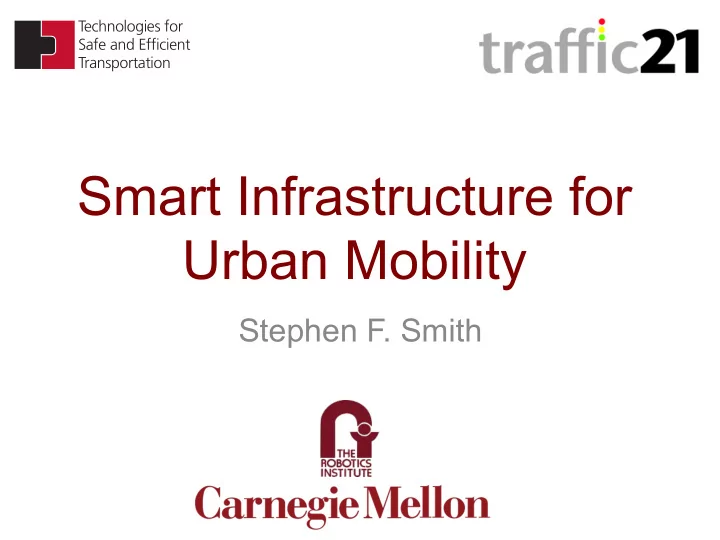

Technologies for Safe and Efficient Transportation Smart Infrastructure for Urban Mobility Stephen F. Smith
TRAFFIC CONGESTION costs $121 billion per year in the US produces 56 billion pounds of CO 2 annually 40% 40% of of time ime spent pent on on sur urface ace street eets in in ur urban ban ar areas eas is is spent pent idling idling Technologies for Safe and Efficient Transportation
POORLY TIMED SIGNALS are one big reason why • Those signal systems with adaptive capabilities have inherent limitations • Vast majority of intersections run fixed plans – Only detect and respond to traffic that is already – Designed for average traffic conditions stopped and waiting – Begin “aging” the moment they are installed – Unable to respond to real-time events – Are designed strictly for arterials Technologies for Safe and Efficient Transportation
Scalable Urban Traffic Control www.surtrac.net Goal: Real-'me op'miza'on of traffic flows for urban (grid) road networks Penn Ave./Penn Circle Technical Approach: – Decentralized control – Coordinated ac/on Research Progress • 2010-11: Development of core Benefits approach • True real-'me response • 2011-12: East Liberty pilot deployment • Mul'ple dominant flows • Scalable, incremental • 2013-15: Expansion of pilot test site deployment • 2015: Integra'on with connected • Mul'-modal op'miza'on vehicle technology Technologies for Safe and Efficient Transportation
Signal Control as a Distributed Online Planning Problem Controller Sensors Intersec'on Scheduler 3. Schedule is communicated to downstream neighbors 1. Current traffic condi'ons are to indicate what is coming extracted from sensor data streams Intersec'on Scheduler 2. System computes phase schedule that op'mizes flow 4 . Rolling Horizon: at intersec'on and sends Scheduling cycle is commands to the controller repeated every few when it is 'me to change seconds Controller phases Technologies for Safe and Efficient Transportation
Surtrac in East Liberty Penn Circle Test Site (Jun 2012): % Travel # of Wait Improv. Time Stops Time Emissions AM rush 30% 29% 48% 24% Mid Day 33% 53% 50% 29% PM rush 23% 9% 36% 18% Evening 18% 35% 28% 14% Overall 26% 31% 41% 21% Bakery Square Expansion (Nov 2013): % Travel # of Wait Improv. Time Stops Time Emissions AM rush 17% 34% 33% 16% Mid Day 21% 37% 38% 18% PM rush 29% 45% 46% 25% Overall 24% 40% 42% 21% Technologies for Safe and Efficient Transportation
Baum Boulevard Highland Ave e u n e v A e r t n e C Fifth Avenue Penn Avenue Technologies for Safe and Efficient Transportation
Pittsburgh Smart City Challenge Vision Technologies for Safe and Efficient Transportation
Integration with Connected Vehicle Technology • Better sensing • Use of mode, route info. • Incident detection and real-time re-routing d r a v e u l 24 intersec=ons are o B Highland Ave e m u u n a e B v A e equipped with DSRC Radio r t n e C Communica=ons e u n e v A Penn Avenue h f t F i Technologies for Safe and Efficient Transportation
Sharing Vehicle Route Information Basic Concept – Connected Vehicle (CV) shares its route with the network – Intersections incorporate this info. into local optimization Initial Results – Average delay is significantly improved – CVs receive immediate benefit – Little adverse effect and overall flow efficiency improves with level of penetration Technologies for Safe and Efficient Transportation
The Longer View • As CV technology emerges the signal network will provide the gateway to real- time control information • AI planning and machine learning techniques will be a key enabler Technologies for Safe and Efficient Transportation
Recommend
More recommend